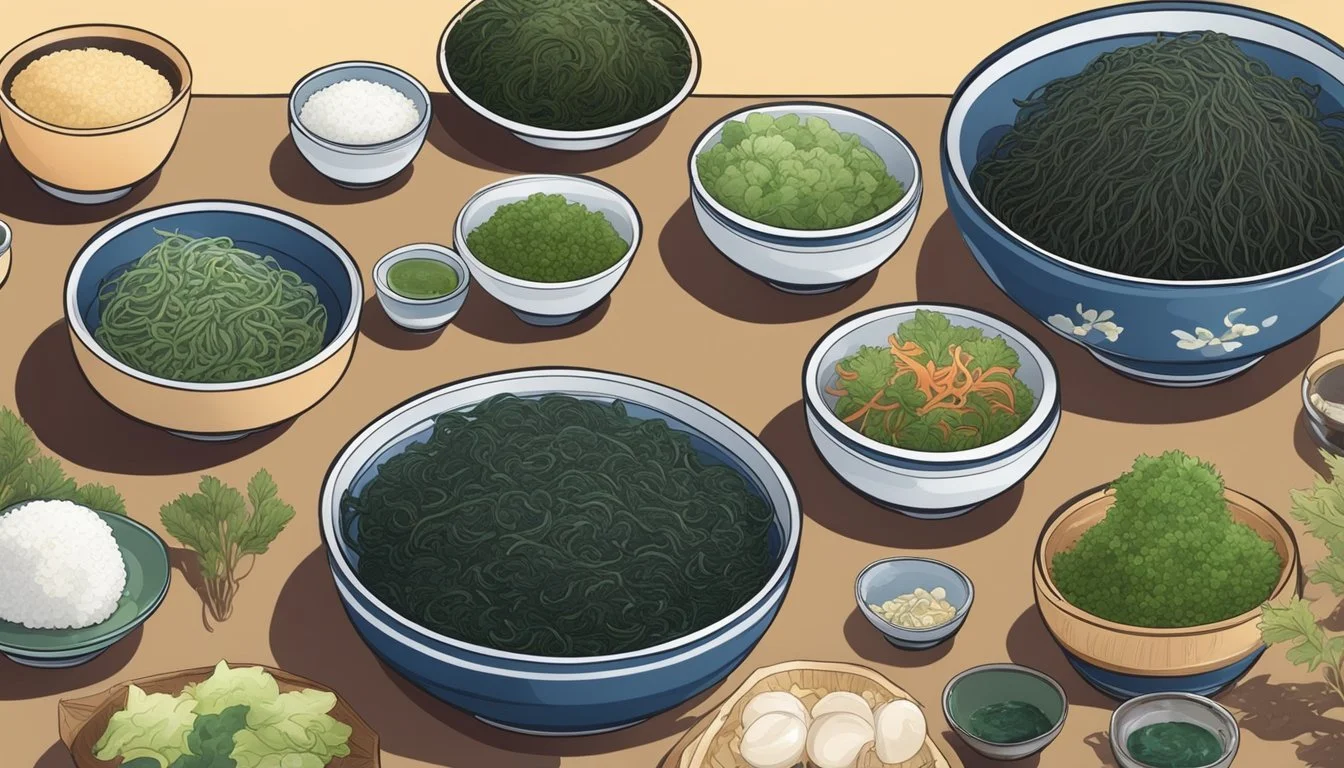Hijiki Substitutes
Top Alternatives for Cooking and Nutrition
For those exploring the world of seaweed, hijiki stands out for its earthy flavor and its rich nutritional profile, packed with dietary fiber, calcium, iron, and magnesium. If hijiki is not available or if concerns about its high levels of inorganic arsenic deter you, there are excellent substitutes that can be seamlessly integrated into recipes. Arame, a close cousin to hijiki, offers a thinner and more tender option with similar flavors, making it a suitable alternative.
For those who prefer a milder taste, wakame provides a less intense seaweed flavor while still delivering essential nutrients. Known for its use in miso soup, wakame can be a versatile replacement. Another option includes using kombu, which can impart a subtle umami flavor when making stocks and broths. Remember, selecting the right substitute can enhance your dish while maintaining the desired nutritional benefits.
Exploring these alternatives ensures you still get the health benefits of seaweed without compromising on flavor or safety. Whether you opt for arame, wakame, or kombu, each of these seaweeds offers unique attributes that can elevate your culinary creations and provide robust nutritional benefits.
Understanding Hijiki
Hijiki seaweed is a nutrient-rich sea vegetable known for its mild flavor and versatility in various dishes. It adds umami, dietary fiber, and essential minerals to soups, salads, and more.
Hijiki Characteristics
Hijiki is a type of brown seaweed that turns black when dried. Before rehydration, it resembles dried black tea. When soaked in water, it expands significantly. The texture becomes tender, making it perfect for various recipes. Though it has a mild, savory flavor, it’s rich in umami, complementing a range of dishes.
Nutritional Profile
Hijiki is valued for its dense nutrient content. It is rich in iron, calcium, magnesium, and dietary fiber. These nutrients are essential for bone health, blood formation, and maintaining digestive health, respectively. Its low calorie content and high vitamin and mineral profile make it suitable for vegan and vegetarian diets. Hijiki's nutritional benefits enhance the overall health appeal of meals.
Culinary Uses
Hijiki is a popular ingredient in Japanese cooking. It can be added to soups and salads, enhancing them with its savory flavor and pleasant texture. Some specific dishes include Hijiki seaweed salad, where it is mixed with vegetables and dressings, and Japanese fried rice, in which it adds both flavor and nutrients. Rehydrated hijiki can be easily incorporated into various vegan and vegetarian recipes.
Popular Hijiki Dishes
Hijiki seaweed, known for its rich nutrient profile, is a staple in various Japanese dishes. These dishes often feature combinations with rice, salads, or preparations that emphasize hijiki's unique texture and flavor.
Simmered Hijiki
Simmered hijiki, or Hijiki no Nimono, is a traditional Japanese side dish. It typically includes hijiki seaweed simmered with carrots, aburaage (fried tofu), and soybeans.
Mirin, soy sauce, and dashi broth form the base of the simmering liquid, giving the dish its characteristic savory-sweet flavor.
This dish highlights the versatility of hijiki, making it a popular choice for adding a healthy component to a Japanese meal.
Hijiki Rice Dishes
Takikomi Gohan
Hijiki is often featured in Takikomi Gohan, a seasoned rice dish where ingredients like hijiki seaweed, thinly sliced carrots, and aburaage are mixed with short-grain rice and cooked together.
The rice absorbs flavors from the soy sauce, mirin, and dashi broth, creating a flavorful and satisfying meal.
Rice Balls
Another popular form is the incorporation of hijiki into rice balls (onigiri). Using hijiki rice stuffed or mixed into rice balls provides a convenient way to enjoy the flavors of hijiki.
These rice balls are an ideal addition to bentos (lunch boxes) and are loved for their portability and nutrition.
Salad Integrations
Hijiki Seaweed Salad showcases hijiki mixed with a variety of vegetables. Edamame, julienned carrots, and sometimes chikuwa (fish cake) are common additions.
The salad is typically dressed with a mixture of soy sauce, sesame oil, and sometimes rice vinegar, providing a light and refreshing complement to the hijiki's texture.
Hijiki can also be integrated into sushi rolls and other salads, enhancing their nutritional value and adding a unique flavor element that pairs well with other ingredients.
By combining hijiki with fresh produce, these salads offer a nutritious and vibrant component to any meal.
Top Hijiki Substitutes
Hijiki, a savory sea vegetable, is known for its earthy flavor and dense nutrient profile. When hijiki isn’t available, several other seaweeds can effectively replace it, each bringing unique tastes and health benefits to dishes.
Wakame Seaweed
Wakame seaweed is a popular alternative due to its subtle sweetness and versatility. This sea vegetable enhances salads, soups, and stir-fries, integrating well in both Japanese and Western dishes. Wakame is rich in nutrients like calcium, iron, and vitamin A. To use wakame, soak it in water until it rehydrates, then add it to your dish. This seaweed has a delicate texture and combines beautifully with soy sauce and a sprinkle of sesame seeds.
Arame Seaweed
Arame seaweed, used extensively in Japanese cooking, offers a slightly sweet flavor with a softer texture. It's a great substitution for hijiki since it absorbs the flavors of the other ingredients in a dish. Arame can be used in salads, soups, and steamed vegetable dishes. Before use, rehydrate arame by soaking it in water for several minutes. This seaweed pairs well with soy sauce, sugar, and other seasonings, making it versatile in savory dishes.
Kombu Seaweed
Kombu seaweed, known for its strong umami flavor, is a key ingredient in making dashi, a fundamental broth in Japanese cuisine. Kombu’s thicker texture adds depth and savory notes to soups and stews. While it does have a briny flavor, it’s less pronounced than other seaweeds, making it suitable for those new to sea vegetables. Kombu is often simmered in water to extract its rich flavors, which can be enhanced with soy sauce.
Nori Seaweed
Nori seaweed, familiar to many as the wrapping in sushi and onigiri (rice balls), offers a different texture and taste compared to hijiki but can still be an effective substitute. Its crispy texture and toasted flavor add a unique element to dishes. Nori is usually used in dry sheets, which can be crumbled over salads, soups, or rice dishes. For a savory touch, try brushing nori with a light soy sauce before roasting to enhance its natural umami.
Dulse Seaweed
Dulse seaweed stands out with its vibrant red color and unique flavor profile, often described as slightly smoky and salty. This seaweed is commonly used in salads and can be eaten raw, adding a nutrient-rich crunch. Dulse is packed with vitamins and minerals, making it an excellent choice for boosting the nutritional value of a meal. It’s versatile enough to be cooked or sprinkled over dishes as a seasoning, bringing a savory flavor enhancement.
Cooking with Hijiki Substitutes
When substituting hijiki in recipes, it is important to adjust seasonings, consider texture, and pair flavors thoughtfully to ensure that the dish remains balanced and flavorful.
Adapting Seasonings
Seasonings need to be adjusted based on the specific substitute used. For example, when using kombu as a substitute, increasing the amount of soy sauce or miso may enhance the umami flavor. If using wakame, it may need less salt due to its naturally salty taste. Adding a bit of mirin or sake can balance the flavors if the substitute is on the sweeter side, such as with sea lettuce.
Adjust sugar levels to balance the brininess of seaweed substitutes, and use fish sauce sparingly to avoid overwhelming other tastes.
Texture Considerations
When substituting hijiki, the texture of the seaweed can significantly alter the dish's final texture. Hijiki is known for its crisp and slight crunch. If using wakame or nori, expect a softer, more silky texture. Agar could be used for a more jelly-like consistency.
Combining tofu, carrots, and mushrooms can add crunchiness or a mushroom-like chewiness to replicate hijiki’s texture. Adding sweet potato chunks or burdock root may help retain some of the original crunch.
Flavor Pairings
Pairing flavors with substitutes of hijiki hinges on their inherent characteristics. For kombu, its strong umami lends itself well to dashi or savory flavor profiles. Pair kombu with soy sauce, sugar, and mirin to create a rich broth.
Wakame works well with lighter seasonings due to its delicate flavor, making it suitable for soups with miso and sake. Balancing umami with sweetness is key; ingredients like carrot, tofu, and shiitake mushrooms complement these flavors well.
Ensuring the proper balance among these elements will help maintain the dish's integrity and appeal, even without hijiki.
Health Considerations
When considering hijiki substitutes, it is important to understand both the health benefits of various sea vegetables and any potential concerns associated with their consumption. This will help in making informed choices for a balanced diet.
Benefits of Sea Vegetables
Sea vegetables like nori, wakame, and kelp are nutrient-dense, making them excellent substitutes for hijiki. These seaweeds are rich in dietary fiber, which supports digestive health by promoting bowel regularity.
They also contain essential minerals such as magnesium, calcium, iron, and potassium. These minerals play vital roles in bone health, muscle function, and overall metabolic processes. Iodine, abundantly found in seaweeds, is crucial for thyroid function, aiding in the regulation of metabolism and energy levels.
Sea vegetables are low in calories, making them ideal for those on a calorie-restricted diet. The presence of vitamins, particularly vitamin K, further enhances their nutritional profile, supporting blood coagulation and bone health. For vegans and vegetarians, sea vegetables also offer a plant-based source of important nutrients that might otherwise be challenging to obtain.
Potential Concerns
While sea vegetables are highly nutritious, they also come with some concerns. Hijiki, for example, has been found to contain high levels of inorganic arsenic, which can pose health risks if consumed in large quantities. It's essential to consume hijiki and its substitutes in moderation.
Another concern is the potential for heavy metal accumulation in sea vegetables due to ocean pollution. It is advisable to source these products from reputable suppliers who test for contaminants.
High iodine levels, while beneficial for thyroid health, can sometimes lead to thyroid dysfunction if intake is not monitored. Individuals with thyroid disorders should consult healthcare professionals before frequent consumption.
Lastly, some sea vegetables may contain substances that can interfere with nutrient absorption. For instance, oxalates in certain seaweeds can bind to calcium, reducing its bioavailability. Therefore, balancing sea vegetable intake with other sources of nutrients is key.
Complementary Ingredients
When incorporating hijiki into dishes, several ingredients can complement its flavor and enhance the overall dish. These include versatile vegetables, flavorful proteins, and other key flavor enhancers.
Vegetable Add-Ins
Shiitake mushrooms, with their rich umami flavor, pair well with the mild taste of hijiki. Fresh or dried, they add depth to soups and stir-fries.
Carrots, sliced into thin rounds or matchsticks, bring a touch of sweetness and a crisp texture.
Lotus root adds a crunchy contrast and subtle nuttiness when thinly sliced. It works well in salads and stews.
Edamame, whether fresh or frozen, can be boiled briefly and added to hijiki salads for a pop of color and a protein boost.
Proteins that Enhance Flavor
Tofu, especially firm or extra-firm varieties, absorbs the flavors of hijiki and other ingredients well. It can be cubed and gently stir-fried or simmered in broths.
Chicken, particularly thigh meat, retains moisture and flavor when cooked with hijiki. Dice or thinly slice the chicken before stir-frying or simmering to ensure even cooking.
Egg, either in the form of scrambled pieces or thin slices of tamagoyaki (Japanese rolled omelet), adds richness and a delicate texture.
Salmon, either grilled or steamed, complements hijiki with its robust flavor and healthy fats. Flake the salmon into small pieces for incorporation into salads and rice dishes.
Other Flavor Enhancers
Sesame seeds (black or white) provide a nutty flavor and appealing crunch when sprinkled over hijiki dishes.
Bonito flakes add a smoky, umami-rich depth, particularly valuable in broths or dashi-based dishes featuring hijiki.
Mirin, a sweet rice wine, balances the earthy flavor of hijiki with its subtle sweetness. Use it in dressings and sauces.
Soy sauce imparts a savory note and umami richness. Light soy sauce offers a gentle saltiness that doesn't overpower hijiki's delicate flavor.








